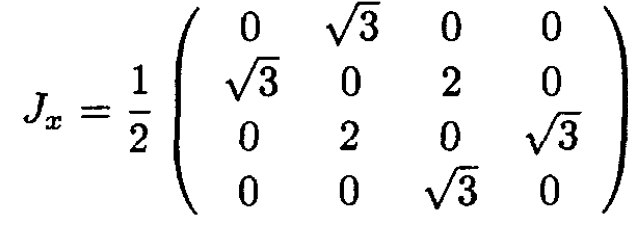
تاريخ الفيزياء

علماء الفيزياء


الفيزياء الكلاسيكية

الميكانيك

الديناميكا الحرارية


الكهربائية والمغناطيسية

الكهربائية

المغناطيسية

الكهرومغناطيسية


علم البصريات

تاريخ علم البصريات

الضوء

مواضيع عامة في علم البصريات

الصوت


الفيزياء الحديثة


النظرية النسبية

النظرية النسبية الخاصة

النظرية النسبية العامة

مواضيع عامة في النظرية النسبية

ميكانيكا الكم

الفيزياء الذرية

الفيزياء الجزيئية


الفيزياء النووية

مواضيع عامة في الفيزياء النووية

النشاط الاشعاعي


فيزياء الحالة الصلبة

الموصلات

أشباه الموصلات

العوازل

مواضيع عامة في الفيزياء الصلبة

فيزياء الجوامد


الليزر

أنواع الليزر

بعض تطبيقات الليزر

مواضيع عامة في الليزر


علم الفلك

تاريخ وعلماء علم الفلك

الثقوب السوداء


المجموعة الشمسية

الشمس

كوكب عطارد

كوكب الزهرة

كوكب الأرض

كوكب المريخ

كوكب المشتري

كوكب زحل

كوكب أورانوس

كوكب نبتون

كوكب بلوتو

القمر

كواكب ومواضيع اخرى

مواضيع عامة في علم الفلك

النجوم

البلازما

الألكترونيات

خواص المادة


الطاقة البديلة

الطاقة الشمسية

مواضيع عامة في الطاقة البديلة

المد والجزر

فيزياء الجسيمات


الفيزياء والعلوم الأخرى

الفيزياء الكيميائية

الفيزياء الرياضية

الفيزياء الحيوية

الفيزياء العامة


مواضيع عامة في الفيزياء

تجارب فيزيائية

مصطلحات وتعاريف فيزيائية

وحدات القياس الفيزيائية

طرائف الفيزياء

مواضيع اخرى
Three Spins
المؤلف:
Sidney B. Cahn, Gerald D. Mahan And Boris E. Nadgorny
المصدر:
A GUIDE TO PHYSICS PROBLEMS
الجزء والصفحة:
part 2 , p 62
22-8-2016
1324
Three Spins
Consider three particles of spin 1/2 which have no motion. The raising (s+ = sx + isy) and lowering (s- = sx - isy) operators of the individual spins have the property
 (i)
(i)
 (ii)
(ii)
where the arrows indicate the spin orientation with regard to the z-direction.
a) Write explicit wave functions for the four J = 3/2 states: (M = 3/2, 1/2, -1/2, -3/2).
b) Using the definition that  construct the 4 × 4 matrices which represent the J+ and J- operators.
construct the 4 × 4 matrices which represent the J+ and J- operators.
c) Construct the 4 × 4 matrices which represent Jx and Jy.
d) Construct from Jx, Jy, Jz the value of the matrix J2.
SOLUTION
a) We use the notation that the state with three spins up is |↑1↑2↑3⟩. This is the state with M = 3/2. We operate on this with the lowering operator J-, which shows that the states |3/2, M⟩ with lower values of M are
 (1)
(1)
 (2)
(2)
 (3)
(3)
 (4)
(4)
b) From the definition of J+ we deduce that
 (5)
(5)
 (6)
(6)
 (7)
(7)
 (8)
(8)
The matrix J- is the Hermitian conjugate of J+:
 (9)
(9)
c) Because Jx = (J+ + J-)/2 and Jy = -i (J+ - J-)/2 we can construct
 (10)
(10)
 (11)
(11)
 (12)
(12)
d) To find the matrix J2 = J2x + J2y + J2z, we square each of the three matrices and add them. This gives J2 = 15Ĩ/4, where Ĩ is the 4 × 4 unit matrix. This is what one expects, since the eigenvalue of J2 is J(J + 1), which is 15/4 when J = 3/2.
 الاكثر قراءة في مواضيع اخرى
الاكثر قراءة في مواضيع اخرى
 اخر الاخبار
اخر الاخبار
اخبار العتبة العباسية المقدسة

الآخبار الصحية















 قسم الشؤون الفكرية يصدر كتاباً يوثق تاريخ السدانة في العتبة العباسية المقدسة
قسم الشؤون الفكرية يصدر كتاباً يوثق تاريخ السدانة في العتبة العباسية المقدسة "المهمة".. إصدار قصصي يوثّق القصص الفائزة في مسابقة فتوى الدفاع المقدسة للقصة القصيرة
"المهمة".. إصدار قصصي يوثّق القصص الفائزة في مسابقة فتوى الدفاع المقدسة للقصة القصيرة (نوافذ).. إصدار أدبي يوثق القصص الفائزة في مسابقة الإمام العسكري (عليه السلام)
(نوافذ).. إصدار أدبي يوثق القصص الفائزة في مسابقة الإمام العسكري (عليه السلام)


















